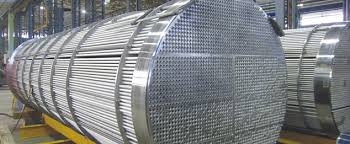Stainless Steel Heat Exchanger
Introduction
Stainless Steel Heat Exchanger is different grades and surface finishes of stainless steel go with the environment the alloy must endure. Stainless steel is used where both the properties of steel and fighting to corrosion. Stainless steel differs carbon steel by the amount of chromium present. Open to attack carbon steel rusts readily when exposed to air and moisture. This iron oxide film active and accelerates corrosion for forming more iron oxide. Stainless steels contain sufficient chromium to form a passive film of chromium oxide, which prevents further surface corrosion and blocks corrosion from spreading into the metal’s internal structure. Stainless steel also known as inbox steel, defined as a steel alloys with a minimum of chromium content by mass. Stainless steel does not flake, rust or stain with water regular steel does, but in spite of the name it is not fully stain-proof. Stainless steel is also called corrosion-resistant steel or CRES the alloy type and not exhaustive, particularly in the aviation industry.
Specifications of Stainless Heat Exchanger:
- Stainless Steel Heat Exchanger incorporates stainless steel components as an alternative to blued or parkerized steel. Some models, such as the Smith and Wesson Model, can be made entirely from stainless steel.
- Stainless Steel Heat Exchanger plating, then the finish is not subject to flaking, peeling, wear-off from rubbing as when repeatedly removed from a holster or rust when scratched.
- Stainless Steel Heat Exchanger automotive manufacturers use stainless steel as decorative highlights in their vehicles.
- Stainless Steel Heat Exchanger gives a high-luster finish similar in appearance to nickel plating.
Applications of Stainless Heat Exchanger:
- Stainless steel’s conflict to decay and staining, low maintenance and familiar make it ideal material for many applications.
- There are over 150 grades of stainless steel, of which fifteen are most commonly used.
- The alloy is milled into coils, plates, bars, wire, and tubing to be used in cookware, cutlery, hardware, surgical instruments, major appliances, industrial equipment and as an automotive and aerospace structural alloy and construction material in large buildings.
Advantages:
- Stainless steels and tankers used to transport orange juice and other food are often of stainless steel, because of its corrosion resistance and antibacterial properties.
- Stainless steels also influences its use commercial kitchens and food processing plants, as it can be steam-cleaned and sterilized and does not need paint or surface finishes.
- Stainless steels are used for jewelry and watches with the type commonly used for applications.
- Stainless steels can be by any jeweller and will oxidize or turn black.
